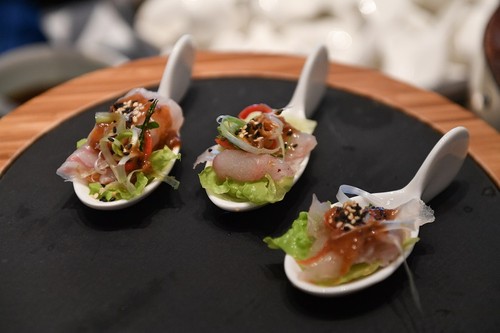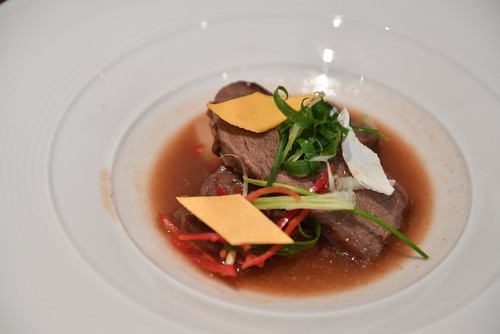 Halibut Hoe Ssam (Photo: Metropole Hanoi Hotel) Halibut Hoe Ssam (Photo: Metropole Hanoi Hotel) |
We have on our show Ms. So Yeon Kim, our culinary guide to Korean Gastronomy Week in Hanoi.
Ms. Kim: We have collaborated with two-star Michelin Chef Sung-Jae Anh. We got the recipe from him because he couldn’t travel due to COVID restrictions. And thanks to chef Raphael Kinimo of Metropole, we were able to bring it to life.
C: So can we expect typical Korean food in this gastronomy week?
Ms. Kim: The purpose of the event is to introduce a little more elevated dining culture of Korea. I know that Vietnamese people really love Korean food and really enjoy it. But I felt there was limitations to what was offered. So kimchi, Korean BBQ, all is delicious and good but there are many more kinds of Korean cuisine that use special ingredients and different cooking methods. I really want to showcase that to the Vietnamese who love Korean food and want to try something different and modern.
C: The menu offers several dishes by Chef Anh, including tiger shrimp and pine nut muchim, a halibut hoe ssam cup with traditional ssamjang dipping sauce and the famous South Korean-style BBQ ribs. Are there any special cooking techniques used on this occasion?
Ms. Kim: Just to give you a simple example, Korea is famous for BBQ, and galbi gui is short ribs which are marinated and grilled. Galbi is normally made with beef short ribs. In this dish, we use the Sous vide technique which is slow and low temperature cooking. So, you have to bathe the meat in airtight vacuum containers for up to 30 hours. At the Metropole, we do it for 12 hours. So, the meat has a really soft texture, but keeps the consistency of meat. After that, we marinate using the chef’s special marinade of ginseng, jujube and Asian pear, and other condiments. That gives it sweet, salty, heavy, all kinds of different flavors, balanced perfectly because the meat is so tender it absorbs the marinade perfectly.
 (Photo: Metropole Hanoi Hotel) (Photo: Metropole Hanoi Hotel) |
C: So chef Anh uses the Sous vide technique to modernize traditional Korean BBQ. By the way, I’ve tried Halibut Hoe Ssam. Basically, it’s like sashimi, but I’m quite impressed with the sauce. Does it involve another special cooking technique you’d like to mention?
Ms. Kim: The name of the dish is Halibut Hoe Ssam. Hoe means “raw fish”, like sashimi, Ssam means “wrap”. It’s basically a wrapped sashimi. But in Korea, there are some techniques for certain types of fish that you age for a few days. By aging the raw fish, the texture will have a chewier, deeper texture and the flavor will increase. For this dish we let the fish age for 3 days. Then it is topped with a sauce called “Ssamjang”. Ssamjang is made from chef Anh’s recipe, using whelks. The whelks give a crunchiness to the sauce and are topped with sliced sashimi leaves. You eat it with crunchy, mild butter lettuce. The butter lettuce gives a fresh feeling to the whole dish.
C: Dishes served as part of this special culinary event will include tiger shrimp and pine nut muchim; a halibut hoe ssam cup with traditional ssamjang dipping sauce; an abalone and beef brisket jjim, marinated in a flavorful sauce before being steamed; ginseng galbi gui, the famous South Korean-style BBQ ribs; and persimmon bavarois served with lemon sorbet.
The à la carte and five-course set menus are now being served for lunch and dinner at Le Club at the Metropole Hanoi Hotel through October 11. Don’t miss this chance to enjoy great modern Korean food. We’ll be back next week with more food ideas. Good bye until then.